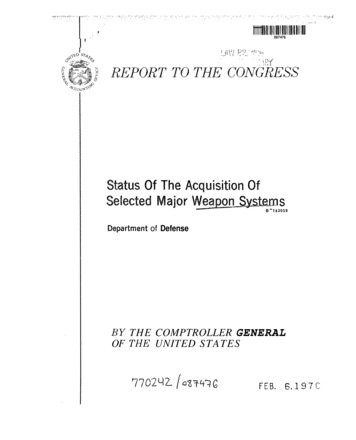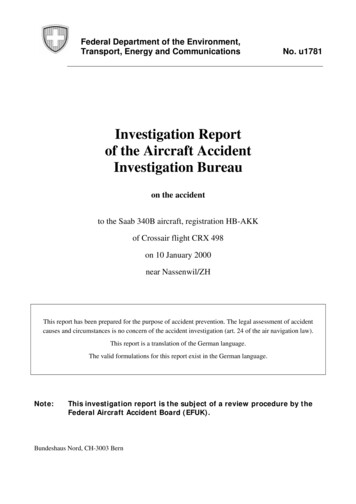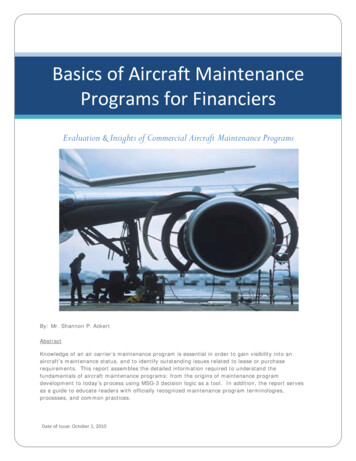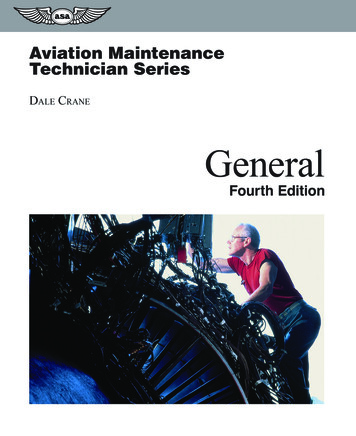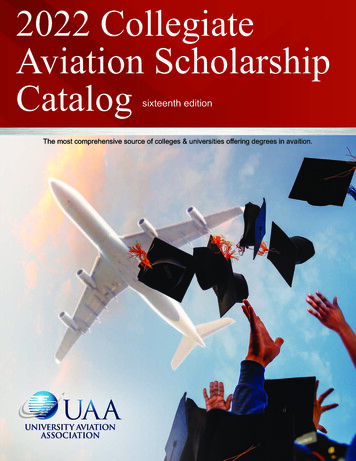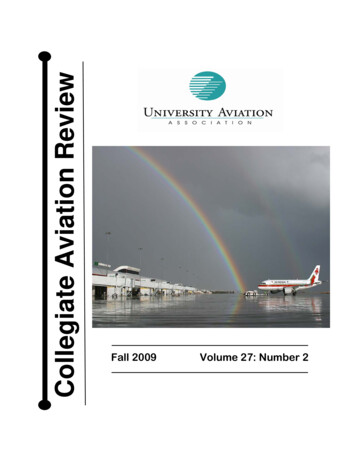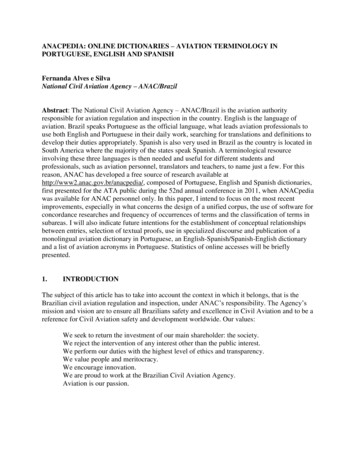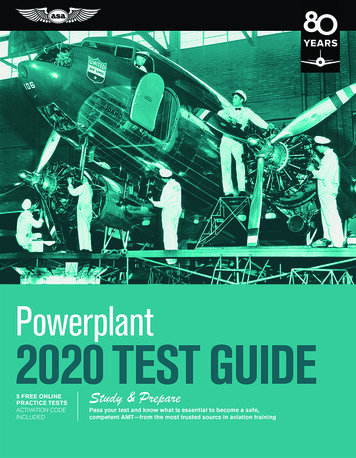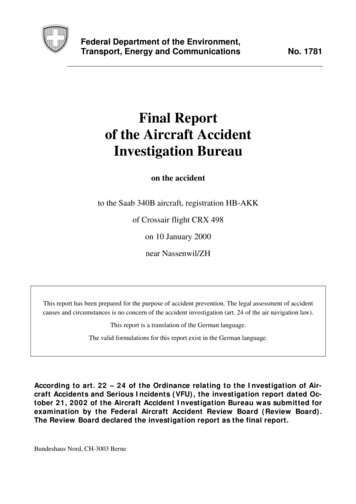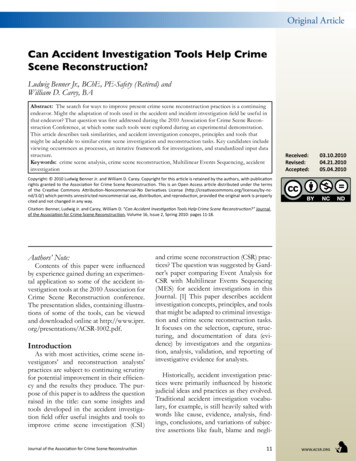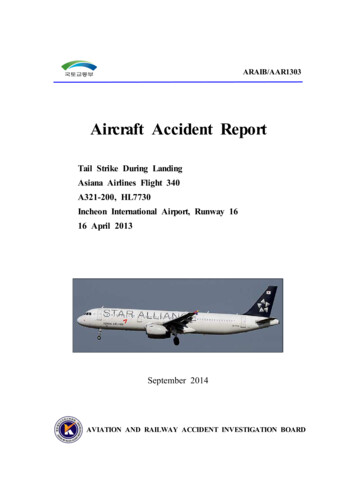
Transcription
ARAIB/AAR1303Aircraft Accident ReportTail Strike During LandingAsiana Airlines Flight 340A321-200, HL7730Incheon International Airport, Runway 1616 April 2013September 2014AVIATION AND RAILWAY ACCIDENT INVESTIGATION BOARD
This aircraft serious incident report has been prepared inaccordance with the Article 25 of the Aviation and RailwayAccident Investigation Act of the Republic of Korea.According to the provisions of the Article 30 of the Aviationand Railway Accident Investigation Act, it is stipulated;The accident investigation shall be conducted separately fromany judicial, administrative disposition or administrative lawsuitproceedings associated with civil or criminal liability.And in the Annex 13 to the Convention on International CivilAviation, Paragraphs 3.1 and 5.4.1, it is stipulated as follows:The sole objective of the investigation of an accident or incidentshall be the prevention of accidents and incidents. It is not thepurpose of the activity to apportion blame or liability. Anyinvestigation conducted in accordance with the provision of thisAnnex shall be separate from any judicial or administrativeproceedings to apportion blame or liability.Thus, this investigation reportshall not be used for any otherpurpose than to improve aviation safety.In case of divergent interpretation of this report between theKorean and English languages, the Korean text shall prevail.
Aircraft Accident ReportAviation and Railway Accident Investigation Board. Tail Strike 30,16AprilA321-200,2013.Incheon InternationalAircraftAccidentReportARAIB/AAR1303, Sejong Special Self-Governing City, Republic ofKorea.The Aviation and Railway Accident Investigation Board (ARAIB),Republic of Korea, is a government organization established forindependent investigation of aviation and railway accident, and iththeprovisions of the Aviation and Railway Accident Investigation Act ernational Civil Aviation.The objective of the investigation by the ARAIB is not to apportionblame or liability but to prevent accidents and incidents.The main office is located in Sejong Special Self-governing City.Address:#94,Dasom2-ro,339-012Tel.: (82)-44-201-5447Fax: (82)-44-201-5698e-mail: araib@korea.krURL: ity,
ContentsAircraft Accident ReportCONTENTSTail Strike During Landing at Incheon International Airport ·········· 1Synopsis ······················· 11. Factual Information ························ 31.1 History of Flight · 31.2 Injuries to Persons ······················· 61.3 Damage to Aircraft ······················ 61.3.1 Damage to the Exterior Fuselage ····················· 61.3.2 Damage to the Interior Fuselage ······················ 71.3.3 Repair and Restoration of the Aircraft Damage ····················· 91.4 Other Damage ······ 91.5 Personnel Information ·················· 91.5.1 The Captain ······· 91.5.2 The First Officer ····················· 101.6 Aircraft Information ··················· 111.6.1 Aircraft History ························ 111.6.2 History of Aircraft Maintenance ····················· 121.6.3 Weight and Balance ················ 131.7 Meteorological Information ········ 131.8 Aids to Navigation ····················· 141.9 Communications · 151.10 Aerodrome Information ············ 171.11 Flight Recorders ······················· 171.11.1 Flight Data Recorder ············ 171.11.2 Cockpit Voice Recorder ······· 201.12 Wreckage and Impact Information ·················· 211.13 Medical and Pathological Information ············ 211.14 Fire ···················· 21- i -
ContentsAircraft Accident Report1.15 Survival Aspects ······················· 211.16 Tests and Research ·················· 221.17 Organizational and Management Information · 231.17.1 Training in the Recovery from the Bounce at Touchdown ······················· 231.17.2 Flight Control for the Prevention of a Tail Strike ············· 251.18 Additional Information ············· 261.18.1 Asiana's Stabilized Approach Criteria ·········· 261.18.2 Use of the Autothrottle for Speed Control · 261.18.3 Delegation of Flight Control to the FO ······ 271.18.4 Approach Briefing by the Flight Crew ······· 291.18.5 Standard Callout and Response Procedures ························· 302. Analysis ················ 342.1 General ················ 342.2 Stabilized Approach ··················· 342.3 Bouncing on Touchdown ··········· 352.3.1 Failure to Maintain the Proper Approach Speed and Bouncing ·················· 352.3.2 Final Approach and Speed Monitoring During Landing ······ 362.3.3 Attention Allocation During Landing ············· 372.4 Tail Strike on Touchdown ········ 382.4.1 Touchdown Maneuvers after Bouncing ········· 382.4.2 Human Factors Relating to Bouncing Landing Recovery Procedures ········· 382.4.2.1 Noncompliance with Regulations and Procedures ·············· 382.4.2.2 Flight Training Program and Proficiency Attainment ········ 393. Conclusions ·········· 413.1 Findings ·············· 413.2 Causes ················· 434. Safety Recommendations ············· 45- ii -
Title, SynopsisAircraft Accident ReportTail Strike During Landing at Incheon International AirportㅇOperator: Asiana AirlinesㅇManufacturer: AirbusㅇType: A321-200ㅇRegistration Mark: HL7730ㅇLocation: Incheon International Airport, Runway 16ㅇDate & Time: 16 April 2013, Approximately 17:37 (KST1))SynopsisOn 16 April 2013, about 17:37, an A321-200 airplane, HL7730, operated byAsiana Airlines as a scheduled international passenger flight, which took offfrom Harbin Taiping International Airport, China for Incheon InternationalAirport, the Republic of Korea, experienced a tail strike while touching down onrunway 16 at Incheon International Airport. As a result of this accident, threeflight attendants were injured, and the airplane sustained substantial damage tothe pressure bulkhead and stringers, and scratches at the exterior skin of the rearfuselage.The Aviation and Railway Accident Investigation Board (ARAIB) determinesthat the causes of this accident were ① The pilot flying (PF) failed to maintainthe proper approach speed until the flare just before touchdown, and the airplanebounced on touchdown since higher-than-normal vertical gravity was applied dueto a high sink rate and increased thrust and speed just before touchdown; and② The airplane made a second touchdown at the pitch attitude exceeding anA321 airplane's limitation and sustained a tail strike since the PF failed to keepthrust at idle and establish the proper pitch attitude during the bounce.1) Unless otherwise indicated, all times stated in the report are Korean Standard Time (KST), based on24-hour clock.- 1 -
Title, SynopsisAircraft Accident ReportContributing to this accident were ① the inadequate training program dealingwith the recovery form the bounce; ② lack of pre-landing preparation due to afailure to conduct an approach briefing on pitch attitude; ③ the PF's failure toproperly allocate his attention due to his delegation of flight control to the pilotmonitoring (PM) who failed to meet flight control requirements; ④ the PM'sinadequate advice and monitoring due to the PF's failure to make standardcallouts; ⑤ the disconnection of the autothrottle and a failure to manuallycontrol thrust and speed; and ⑥ a failure to execute a go-around whenstabilized approach criteria are not met.Regarding this accident, the ARAIB addresses four safety recommendations toAsiana Airlines and two safety recommendations to the Ministry of Land,Infrastructure and Transport (MOLIT).- 2 -
Factual InformationAircraft Accident Report1. Factual Information1.1 History of FlightOn 16 April 2013, about 15:46, Asiana Airlines flight 340 (hereafter referredto as "HL7730"), took off from Harbin Taiping International Airport, China forIncheon International Airport (hereafter referred to as "Incheon Airport"), passedan altitude of 4,200 meters (14,000 ft)2) after takeoff, checked weather conditionsat Incheon Airport, made an in-flight announcement, continued to climb, andentered the en-route flight phase at a cruising altitude of 9,200 meters.About 16:52:07, HL7730 was given an instruction to descend to 8,900 metersand then, to fly 6 miles to the right of its flight route by Dalian Area ControlCenter (ACC), China.About 17:08:31, the captain started to explain to the first officer (FO) how touse the primary flight display (PFD) and said, "Try to manage the descentprofile although you will not make a landing." At this time, the FO asked, "CanI do that although I have yet to accumulate 100 flight hours?" The captainreplied, "Do not land the airplane."About 17:10:49, HL7730 communicated with Incheon ACC and was given itsinstruction to fly direct to "AGAVO3)" and operate on the airway according toits flight plan.About 17:12:56, HL7730 requested Incheon ACC to allow its descent whileapproaching waypoint AGAVO. After given an instruction to "descend to 15,000ft via waypoint REBIT4)" about 17:14:40, HL7730 made a descent.2) In the Chinese airspace, a meter is used as a metric unit of an altitude.3) A major point on airway G597, in an encounter with Incheon flight information region (FIR).4) A point on airway Y644 in parallel with airway G697.- 3 -
Factual InformationAircraft Accident ReportAbout 17:20:04, the captain said to the FO, "Manually fly the airplane," andthe FO gave an affirmative response. About 17:20:30, the FO switched tomanual flight, calling out "manual flight" From this moment on, the FO was thePF, and the captain was the PM.While making first contact with Seoul ACC about 17:21:42, HL7730 listenedto the Automated Terminal Information Service (ATIS) "Yankee" broadcast andstated that it was maintaining 15,000 ft. Then, given radar vector to the finalapproach course to runway 16, the airplane intercepted the final approach course,using the ILS approach.When HL7730 intercepted the final approach course about 17:33:33, the PMcalled out "manage speed," followed by the PF's callout, "check." About17:33:57, "gear down" was performed on the final approach course, about 7 NMfrom the runway.When HL7730 was on course (LOC star) about 17:34:08, the PM reported"on course" to Seoul ACC's arrival control, which then transferred HL7730 tothe Incheon Control Tower.About 17:34:21, the PF selected flap "3" as advised by the PM, and about17:34:32, the Incheon Control Tower cleared HL7730 for landing, givinginformation on wind 10 kt at 220. About 17:34:37, flap "full (25 )" wasselected, followed by no callout by the PM.About 17:34:43, the captain was informed by the tower that base ceiling was200 ft, and about 17:34:48, took over control of the flight and became the PF,stating "I have control, base ceiling is too low, two hundred."About 17:35:02, the PF called out "set go-around altitude," and the PM set it- 4 -
Factual InformationAircraft Accident Reportas 3,000 ft.About 17:35:13, the PF stated, "add 1 kt to final speed," and the PM replied,"VAPP 138 set." About 18:35:20, the PF called out "landing checklist," and thePM completed the checklist about 17:35:29.According to the FDR data, about 17:35:36, the autothrottle was disconnectedwhen the airplane was at about 137.6 kt at an altitude of 1,209 ft AGL, 6,465meters (3.49 NM) from the runway threshold, but the PF made no callout.About 17:35:50, the PM called out "one thousand" when the airplane was at138.5 kt at an altitude of 1,000 ft AGL, and the PF replied "stabilized," adding"right cross wind at 10 kt," followed by the PM's reply, "check."About 17:36:30, the PM called out "five hundred" when the airplane was at143.1 kt at an altitude of 500 ft AGL, and the PF replied, "stabilized."Subsequently, when an electronic voice announced "400 ft AGL" and later "300ft AGL," the PF and the PM replied.About 17:36:47, the PM called out "one hundred above" and "minimum"when the airplane was approaching 300 ft and 200 ft, respectively. When anelectronic voice announced "two hundred" about 17:36:56, the airplane was at135 kt, and the PF stated, "continue, in sight." About 2 seconds later, the PMstated, "runway in sight."When an electronic voice announced "one hundred" about 17:37:04, theairplane was at 137.6 kt, and the PF stated, "Mmm, this is CAT-Ⅲ." About17:37:07, the airplane was at 131.4 kt at an altitude of 59 ft AGL (near therunway threshold), and about 17:37:09, at 129 kt at an altitude of 29 ft AGL(flare point) at a pitch angle of 3.2 .- 5 -
Factual InformationAircraft Accident ReportAbout 17:37:11, HL7730 bounced when it touched down at a lower angle(2.276 5)) than standard 3 , about 155.3 meters from runway 16 threshold, and atthis time, the airplane was at 135.9 kt at a pitch angle of 6.7 at an attackangle of 15.5 , with vertical gravity of 1.965 g and an increase of thrust.About 5 seconds after touchdown and bouncing, HL7730 touched down againabout 491.3 meters from runway 16 threshold, making a sound of crash againstthe ground. At this time, the airplane was at 136.9 kt at a pitch angle of 10.9 at an attack angle of 23.2 with vertical gravity of 1.715 g and a higher thrustthan that at initial touchdown. Then, HL7730 completed the landing roll andtaxied to ramp 129 for itself.1.2 Injuries to PersonsAboardtheaircraftwere twopilots,nineflightattendants,and128passengers, and three flight attendants sustained minor injuries6).1.3 Damage to Aircraft1.3.1 Damage to the Exterior FuselageAs shown in [Figure 1], as the belly of the rear fuselage contacted the groundduring landing, it sustained abrasion damage 100 cm wide and 600 cm long,including wear-through. The drain mast was bent to the side.5) The angle is recorded as -0.181 DDM (Difference in Depth of Modulation) by the FDR. Since 0.001DDM is 0.004, -0.181 DDM is converted into 2.276 .6) Refer to Section 1.15 Survival Aspects.- 6 -
Factual InformationAircraft Accident ReportSkin DamageDrain Mast[Figure 1] Damage on the Exterior Surface of the Rear Fuselage1.3.2 Damage to the Interior Fuselage[Figure 2] shows damage to the interior fuselage. Out of frames, majorstructure of the fuselage, 11 of them from No. 62 to 72 were cracked ordeformed. Also, nine stringers7) in the same location, from STGR39LH toSTGR41RH, were damaged.CGO floor cross beam at FR62, FR63, and FR64 was damaged, and PAXfloor cross beam at FR65 and FR70 was fractured.The supports for the water tank and the waste water tank were damaged.7) STGR39LH - STGR43LH, STGR44, STGR42RH - STGR43RH.- 7 -
Factual InformationAircraft Accident ReportFrameCross BeamStringerAPBSupport for Cabin FloorSupport for Bulk Cargo Comp.[Figure 2] Damage to the Interior of the AirplaneAs shown in [Figure 3], part of the dished segment was deformed or torn atthe 6 o'clock position of the aft pressure bulkhead (APB).[Figure 3] Damage to the Dished Segment- 8 -
Factual InformationAircraft Accident Report1.3.3 Repair and Restoration of the Aircraft DamageAs shown in [Figure 4], major repair or replacement of the affectedcomponents were performed with technical support of the manufacturer's AOGteam for about three months and completed on 12 August 2013. The cost ofrepairs was about 3.7 billion won ( 3.37 million) including personnel expenses.[Figure 4] Aircraft Repair1.4 Other DamageThere was no other damage.1.5 Personnel Information1.5.1 The CaptainThe captain (age 46, male) held a valid air transport pilot license,8) A321type rating,9) a first-class airman medical certificate,10) an aeronautical radio8) License No.: 11-003982 (acquired on 26 Jan. 2011).9) Acquisition Date: 21 Aug. 2003.- 9 -
Factual InformationAircraft Accident Reportoperator license,11) and level 4 ICAO English Proficiency Certificate.He had accumulated 7,530 total flight hours, including 1,914 hours duringmilitary service and 2,892 hours in A321 airplanes, 722 hours of which he hadaccumulated as pilot-in-command. The captain had flown 116 and 74 hours inthe 90 and 30 days, respectively.The captain was hired by Asiana Airlines in September 2002 and promoted tocaptain on A321 in March 2012 after having served as the first officer on A321and B747-400. He completed his simulator training and passed his proficiencycheck from 16 to 17 January 2013 to be qualified for stage 3 - low visibilityIFR flight. He also passed his line check on 10 March 2013.In the 72 hours before the accident, on 13 April, the captain had a flight toBusan in the morning and took a rest for the rest of the day. On 14 April, Hewas on a roundtrip from Jeju to Fukuoka back, returning to Gimpo Airport as adeadhead crew.12) On 15 April, he was off duty and engaged in routineactivities at home. He went to sleep about 22:30.He did not drink any alcohol or take any illegal medication in the 24 hoursbefore the accident flight and was in good health.1.5.2 The First OfficerThe FO (age 32, male) held a valid air transport pilot license,13) A321 typerating,14) a first-class airman medical certificate,15) an aeronautical radio operatorlicense,16) and level 4 ICAO English Proficiency Certificate.10)11)12)13)14)15)Certificate No.: 062-11021 (valid until 31 Aug. 2013).License No.: 03-34-1-0109 (issued on 3 Sep. 2003).Seated in the cabin.License No.: 12-008273 (acquired on 15 May 2012).Acquisition Date: 5 Feb. 2013.Certificate No.: 062-11686 (valid until 31 Jan. 2014).- 10 -
Factual InformationAircraft Accident ReportHe had accumulated 383 total flight hours, including 128 hours in A321airplanes. He had flown 128 hours in the 90 days and completed his A321 FOtraining two weeks ago, since when he had accumulated 33 hours and 31minutes as second-in-command.He was hired as the FO by Asiana Airlines on 18 June 2012 since hiscivilian flight experience was recognized. He received his ground and flighttraining on A321, passed his checkride, and was appointed the A321 FO on 2April 2013.In the 72 hours before the accident, on 13 April, the FO was on tworoundtrips from Gimpo to Jeju and back. On 14 April, he was off duty, went tochurch, met his friends, returned home, and took a rest. On 15 April, he was ona roundtrip from Incheon and Gimpo and back in the morning and took a restin the afternoon. He went to sleep about 23:00. In the morning on the day ofthe accident, he was on the first leg of a roundtrip from Incheon to Harbin withthe captain, and on the way back to Incheon, had the accident during landing.He did not drink any alcohol or take any illegal medication in the 24 hoursbefore the accident flight and was in good health.1.6 Aircraft Information1.6.1 Aircraft HistoryThe aircraft was an A321-200 airplane manufactured17) by Airbus on 20 April2004 and delivered new to Asiana Airlines on 14 May 2004. It was registered18)with the Ministry of Land, Infrastructure and Transport in Korea and held a16) License No.: 09-34-1-0617 (issued on 15 Mar. 2012).17) Manufacturing No.: 2224.18) Registration No.: 2008-321.- 11 -
Factual InformationAircraft Accident Reportvalid airworthiness certificate.19)Until 16 April 2013, the airplane had accumulated 30,268 total hours and13,619 total cycles.The airplane was powered by two V2533-A5 turbofan engines manufacturedby the US International Aero Engines (IAE). The left No. 1 engine and theright No. 2 engine had accumulated 19,891 service hours/10,534 cycles and4,351 service hours/2,040 cycles, respectively.The dimensions of HL7730 are shown in [Figure 5].[Figure 5] Aircraft Dimensions1.6.2 History of Aircraft MaintenanceOn the day of the accident, Asiana Airlines' aircraft mechanic stationed inHarbin Taiping International Airport carried out preflight inspection of HL7730before takeoff, but no fault was not only found but also reported until its arrivalat Incheon Airport.19) Certificate No.: AB12042 (issued on 29 Aug. 2012).- 12 -
Factual InformationAsianaAirlinesAircraft Accident cordance with its maintenance program: "A" check20) on 21 February 2013;"C" check21) on 18 May 2012; and "D" check22) on 27 March 2013.1.6.3 Weight and BalanceThe weight and balance data of HL7730 is as follows:Zero Fuel Weight (ZFW)63,351 kg (Max. Permitted Limit 71,499 kg)Takeoff Weight (TOW)72,286 kg (Max. Permitted Limit 88,999 kg)Landing Weight (LDW)66,798 kg (Max. Permitted Limit 75,499 kg)Takeoff Weight C.G. % MAC32.7% MAC (Range: 14 - 34% MAC)1.7 Meteorological InformationA METAR report filed when HL7730 landed at Incheon Airport about 17:37is as follows:METAR 0800Z 230/09 8000 BR SCT 500 OVC 2,500 11/8 QNH 1003 hPa(17:00, wind 230 at 9 kt, visibility 8 km, scattered at 500 ft, overcast at 2,500ft, temperature 11 C, pressure 1003 hPa)According to ATIS "Yankee" HL7730 tuned into, weather conditions atIncheon Airport were surface wind 220 at 10 kt, and other meteorologicalfactors were the same as those in the METAR report above, issued at 17:00.When HL7730 on the runway 16 final approach course was cleared for20) Check interval: every 750 hours/750 cycles or 4 months, whichever comes first.21) Check interval: every 7,500 hours/5,000 cycles or 24 months, whichever comes first.22) Check interval: 6 years.- 13 -
Factual InformationAircraft Accident Reportlanding, surface wind was 220 at 10 kt, and visibility and base ceiling on thecourse were at such a level that the approach lighting system started to be ininsight when HL7730 crossed 200 ft AGL.According to the FDR data, when HL7730 was at 100 ft on the finalapproach course, at the runway threshold, and at touchdown, wind was 217.3 at19 kt, 218 at 16 kt, and 234.8 at 12 kt, respectively.According to Incheon Airport's LLWAS and TDWR data, there was no windshear when HL7730 approached and landed at runway 16.1.8 Aids to NavigationWhen HL7730 on an ILS runway 16 approach landed, the ILS was in normaloperation, and the approch lighting system, runway edge lights, and PAPI wereilluminated.23)Images recorded by Incheon Airport's Airport Surface Detection Equipment(ASDE) when HL7730 landed are shown in [Figure 6], which show when andwhere HL7730 passed the runway threshold, performed the initial and secondtouchdowns, sustained a tail strike, and vacated the runway.23) Confirmed by the records of the "airfield lighting on-off device."- 14 -
Factual InformationAircraft Accident ReportRWY Threshold1st Touchdown2nd TouchdownVacating RWYRWY 16[Figure 6] Major Images Recorded by the ASDE During Landing1.9 CommunicationsThe major content of the ATC/pilot communications is shown in [Table 1],and no communication problems were reported.- 15 -
Factual InformationTimeAircraft Accident ReportTransmitterContentDarlian control Asiana 340, 3 mile right of track,maintain 9,200 m.16:44:04 DAECON Asiana 340 Darlian control radar contact.16:52:07 DAECON Asiana 340 descend and maintain 8,900 m.16:52:14F/ODescending to 8,900 m, Asiana 340.Incheon control Asiana 340 good afternoon, maintaining17:10:49F/O8,900 m, 6 mile right of track.Asiana 340 radar contact direct AGAVO, then flight plan17:11:50 ICNCONroute.Incheon control Asiana 340 approaching AGAVO, request17:12:56CAPTfor descend.17:14:40 ICNCON Asiana 340 descend to flight level 150 via RAVIT.Seoul approach good afternoon, Asiana 340, information17:21:42CAPTYankee, maintaining flight level 150.Asiana 340 Seoul approach radar contact, fly heading 080,17:22:07SAPPdescend and maintain 13,000.Asiana 340, turn right, heading 120, cleared ILS runway17:33:08SARR16 approach.Right turn heading 120, cleared ILS runway 16 Approach,17:33:14CAPTAsiana 340.17:34:08CAPTAsiana 340 established localizer.17:34:12SARRAsiana 340 contact tower 118.8.Tower, AAR340 established localizer, runway 16, good17:34:25CAPTafternoon.Good afternoon, AAR340 Incheon tower, wind 22017:34:31TWRdegrees 10 knots, runway 16, cleared to land.17:34:39CAPTCleared to land runway 16, AAR340.17:34:42TWRAAR340, advice, base ceiling is 200 feet.17:34:47CAPTAAR340.17:37:04 CSN369 Tower CSN369, good afternoon, now runway 16.CSN369, now surface wind 220 degrees 12 knots17:37:26TWRmaximum 16 knots, base ceiling is 200 feet.17:38:06TWRAAR340, taxi via November then Mike 7.17:38:10F/OTaxi via November then Mike 7, AAR34016:43:55F/O※ F/O: First Officer, CAPT: Captain, DAECON: Darlian Area Control Center, ICNCON: Incheon AreaControl Center, SAPP: Seoul Approach Control Approach Sector, SARR: Seoul Approach Control ArrivalSector, TWR: Incheon Control Tower.[Table 1] Major Content of ATC/Pilot Communications- 16 -
Factual InformationAircraft Accident Report1.10. Aerodrome InformationIncheon Airport's runway 16 is 4,000 meters long and 60 meters wide, pavedwith asphalt. Its touchdown zone is at an elevation of 22.9 ft MSL.Runway 16's tail skid mark left by HL7730 during landing is shown in[Figure 7]. The mark began about 491 meters from the runway threshold, about2.2 meters24) to the right of the runway centerline, as shown in [Table 2].Distance Marker1,000 ft from RWY ThresholdRWY 16 ThresholdTail Skid MarkLanding Dir.[Figure 7] Tail Skid Mark on Runway1.11 Flight Recorders1.11.1 Flight Data Recorder24) Measured during the on-scene investigation.- 17 -
Factual InformationAircraft Accident ReportHL7730 was equipped with the solid-state flight data recorder (FDR, PartNo.: 980-4700-042, Serial No.: 5400) manufactured by Honeywell. On the day ofthe accident, the FDR was retrieved from the scene and sent to the ARAIB'sanalysis lab for readout and evaluation. Visual inspection revealed that the FDRwas free from damage.The FDR recorded data for the 25 hours before the engine shutdown. TheARAIB retrieved this 25 hours worth of raw data, from which it collected about1,100 parameters. Major parameters are not only shown in [Table 2] but alsodisplayed graphically in [Figure d 8Auto 3410.972.34/84.0023.21.715491.3[Table
Landing, Asiana Airlines, HL7730, A321-200, Incheon International Airport, Runway 16, 16 April 2013. Aircraft Accident Report ARAIB/AAR1303, Sejong Special Self-Governing City, Republic of Korea. The Aviation and Railway Accident Investigation Board (ARAIB), Republic of Korea, is a government organization established for
